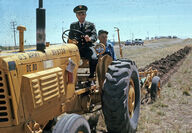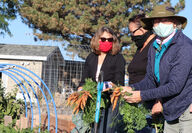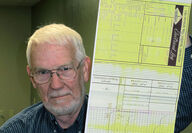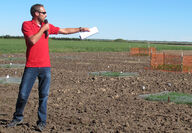Sorted by date Results 1 - 7 of 7

Bob Harveson embarked on his career as a plant pathologist in the mid-1980s, which in 1999 took him to Scottsbluff as a specialist on the faculty at the University of Nebraska Panhandle Research, Extension and Education Center. But before switching to science, Harveson earned a bachelor’s degree in history, and now the two interests are coming together in the form of a book he has authored, “A Century of Plant Pathology in Nebraska.” The 114-page book was published in December 2020 by Zea Books...

As the new year begins, all is quiet at the research plots at the High Plains Agricultural Lab 6 miles northwest of Sidney. Winter wheat fields are dormant, and other fields await the spring planting season. But inside, scientists and support staff are analyzing data, planning for 2021 and completing other tasks to carry out research aimed at helping crop and livestock producers in this semi-arid region be more efficient, sustainable and profitable. The High Plains Ag Lab is operated by the Univ...

The COVID pandemic of 2020 has contributed to increased food insecurity for many Nebraska families. In response, communities have pitched in to help. And some of the donated food is produce that has been grown this year at community gardens around Nebraska, which leverage local volunteers with grant funds from Growing Together Nebraska (GTN), part of Nebraska Extension’s Supplemental Nutrition Assistance Program-Education (SNAP-Ed) program. Established in 2016, Growing Together Nebraska i...
A multi-disciplinary team of University of Nebraska-Lincoln researchers will conduct a two-year study to see how soil nitrogen levels affect protein levels in the grain that comes from Nebraska wheat fields. The team hopes to evaluate how grain quality, yield and field stands are affected by nitrogen fertilizer rates and application timing. The trials will be conducted across the state and with variations in the amount of precipitation the plots receive. The project also will test the effectiveness of crop sensors in monitoring wheat crop...
More than 100 boys and girls from communities throughout the western half of Nebraska spent the better part of a recent Saturday together, in a competition that rewarded their imagination, creativity, cooperation and good sportsmanship. On the line was a trip to compete at the state level. It was a day of competition and games, but it wasn’t athletic. It was a regional qualifying meet for FIRST Lego League, a global program sponsored by FIRST, a non-profit designed to inspire young people’s interest and participation in science and tec...

Several organizations on local and state levels are pooling efforts and money, along with additional funding from the Nebraska Environmental Trust, in a project designed to improve understanding of groundwater hydrogeology in the Nebraska Panhandle by collecting and digitizing decades' worth of data from thousands of oil and gas well logs. The well log information will be combined with other, existing data to give scientists and resources agencies a more detailed understanding of the High...

Damage from the wheat streak mosaic virus costs wheat growers a lot of money in western Nebraska and other wheat-growing regions of the High Plains. How do environmental conditions affect the spread of the virus and the risk of disease? Answering that question is one of the objectives of a U.S. Department of Agriculture grant project that is funding research at the University of Nebraska-Lincoln High Plains Ag Lab (HPAL) near Sidney and other wheat-producing areas. One of the goals of the USDA...